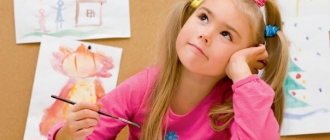Interaction between the speech therapist and other specialists.
Interaction of a speech therapist with specialists from a preschool educational institution in working with children of senior preschool age with general speech underdevelopment
Author: Yakovleva Anastasia Sergeevna
Organization: MBDOU "Kindergarten No. 66"
Locality: Chuvash Republic, Cheboksary
INTRODUCTION
One of the leading lines of modernization of education is the achievement of a new modern quality of preschool education, which takes into account the social order of the state and family for educational services, organizes the active interaction of all participants in the educational community, and is aimed at creating in the child the prerequisites for educational activities that ensure social success, integrative qualities and development personality in general.
Analyzing the situation that has developed today in the preschool education system, the number of children with deviations in speech development has become very noticeable. Such children constitute the main risk group for academic failure, despite the fact that they have full hearing and intelligence. Adequate methods, organizational forms of working with children with severe speech disorders, targeted influence, help to overcome the speech deficiencies that children have. Therefore, when talking about working with children with severe speech impairments, one cannot consider only the activities of a speech therapist teacher. To eliminate speech disorders and form a speech base, close interaction of all participants in the pedagogical process is necessary, where the leading and coordinating role belongs to the speech therapist teacher.
At this time, the correctional program is being rethought and thoughtfully taking into account the Federal State Standard for Preschool Education. The effectiveness of correctional and developmental work with children of senior preschool age with speech impairments will be significantly increased in the conditions of interaction between all specialists of the educational institution.
- Interaction in the work of a speech therapist and educator
Compensation for a child’s speech underdevelopment, his social adaptation and preparation for further education at school dictate the need to master all types of activities that are provided for in the basic general education program of preschool education.
In the process of mastering various types of activities in five educational areas, in accordance with the Federal State Educational Standard, the educator must take into account the individual characteristics of children with speech impairments, promote the development of both speech and non-speech processes (thinking, perception, memory) of pupils.
The teacher’s task is to create a friendly environment in the children’s team, strengthen faith in one’s own capabilities, and relieve negative experiences associated with speech impairment. The implementation of educational tasks is possible on the basis of good knowledge of the age and individual psychophysiological characteristics of children.
Correctional and developmental work is carried out in various directions depending on the tasks set by the speech therapist. In many cases, it precedes speech therapy directly educational activities, providing the necessary cognitive and motivational basis for the formation of speech skills; in other cases, the teacher focuses his attention on consolidating the results achieved in the correction of speech disorders in speech therapy classes.
The teacher’s task also includes daily monitoring of the state of children’s speech activity in each period of the correction process. The teacher observes the manifestations of children's speech activity, the correct use of assigned or corrected sounds in the preschoolers' own speech, acquired grammatical forms, etc. If necessary, the teacher corrects the child's speech in a tactful manner. When correcting an error, you should not repeat the incorrect form or word; pointing out the fact of the error, you need to give a speech sample and invite the child to pronounce the word correctly. It is important that children, under the guidance of a teacher, learn to hear grammatical and phonetic errors in their speech and correct them independently; for this, the teacher attracts the child’s attention to his speech and encourages him to correct errors independently. If the dialogue between the teacher and the child is highly emotional in nature, it is not always advisable to interrupt the child’s speech to correct mistakes; it is preferable to use “delayed correction.” The teacher’s speech should serve as a model for children with speech disorders: be clear, extremely intelligible, well-intonated, expressive. When addressing children, complex inverted constructions, repetitions, and introductory words that complicate the understanding of speech should be avoided.
Thus, the teacher is obliged to know well the real and potential abilities of preschoolers, to carefully study what the child can do on his own and what he can do with the help of an adult.
In the process of education, it is important to organize the possibility of interpersonal communication between children and joint games. In preschoolers, not only communication skills are formed and consolidated, but also a positive background is created for the regulation of speech behavior.
The basis for carrying out direct educational activities on speech development is the gradually expanding knowledge of children about the surrounding life in accordance with the intended topic (“Autumn”, “Professions”, “Clothing”, “Utensils”, “Food”, “Toys”, “Autumn”) ", "Vegetables", "Fruits", etc.).
In didactic games with objects, children learn the names of objects and their distinctive features in all lexical groups. Preschoolers conduct basic observations of natural phenomena and identify characteristic signs of the season.
The formation of vocabulary and grammatical structure in the direct educational activities of the teacher is carried out in stages: 1) children become directly acquainted with the phenomenon being studied;
2) children, with the help of a clear sample of the teacher’s speech, learn to understand the verbal designations of these phenomena;
3) the teacher organizes speech practice for children, in which verbal expressions related to the phenomena being studied are reinforced. The significance of the listed stages is different in each period of training. At first, the leading forms of work are such forms of work as familiarization with fiction, looking at pictures and conversations on issues, repetition of descriptive stories, and the teacher’s use of didactic games. Particular attention is paid to teaching children the ability to accurately answer the question posed (with one word or a complete answer). The complication of speech tasks correlates with the correctional work of the speech therapist. A certain place in this work is given to the correction of sound pronunciation. When studying each topic, together with the speech therapist, the minimum vocabulary (subject, verb, vocabulary of signs) is outlined, which children must first master in understanding, and then in practical use. A vocabulary intended for understanding speech must be much wider than for active use in speech. The teacher clarifies with the speech therapist what types of sentences should prevail during the appropriate period of education, as well as the level of requirements for children’s independent speech.
All of the listed areas of work are reflected in frontal classes conducted by a speech therapist, where an important role is assigned to the teacher in the form of individual assistance (based on the model, joint actions, by analogy).
The interaction and continuity in the work of the speech therapist and the teacher is reflected in the “Journal of the relationship between the speech therapist and teachers”, where speech therapy games and exercises for each lexical group are developed for each week for the entire academic year (1 week - 1 lexical topic), taking into account calendar and thematic planning .
- Interaction in the work of a speech therapist and preschool specialists
The interaction of the speech therapist teacher with pre-school specialists is carried out as follows:
- teacher-speech therapist and educator - pedagogical diagnostics, preparation and implementation of individual development programs, implementation of educational programs, participation in psychological, medical and pedagogical consultations;
- teacher-speech therapist and deputy head of educational work - assistance in organizing interaction, coordination functioning, monitoring results, analyzing correctional work;
- teacher-speech therapist and medical workers - medical examination of children, study of anamnesis, determination of the possible load for each child, preparation of consultations;
- teacher-speech therapist and music director - pedagogical diagnostics, logorhythmics, musical and speech games, chants based on pure tongues;
- teacher-speech therapist and physical education instructor - pedagogical diagnostics, motor activity, breathing exercises, speech load, games and exercises for the development of fine motor skills, coordination of speech with movement.
The speech therapist conducts scheduled and individual consultations at the request of specialists.
The main tasks of interaction between preschool education specialists:
1. Creating a team of like-minded people from all specialists (teacher-speech therapist, educational psychologist, educators, music director, physical education instructor) and improving their professional level.
2. Organization of a correctional and developmental environment that stimulates the child’s speech and personal development.
3. Development of a map of interaction with specialists, built on the basis of comprehensive diagnostics.
4. Development of “Speech therapy five-minute lessons” taking into account the calendar and thematic plan, which are designed for the entire academic year and cover certain lexical topics, taking into account the federal state standard for the structure of the basic general education program of preschool education.
5. Selection of games and exercises for development:
- general and fine motor skills (include outdoor games, ball games, finger gymnastics);
- lexico-grammatical categories and coherent speech (games and exercises for generalization, differentiation, formation of relative adjectives, nouns with diminutive suffixes, use of prepositions, etc.);
- prosodic side of speech (exercises to develop diaphragmatic breathing, long smooth exhalation, deep inhalation, speech breathing, voice strength, tempo and rhythm of speech);
- phonetic side of speech,
- auditory attention and phonemic hearing (games “Attentive Ears”, “Give me a Word.”);
- mental processes (games to develop visual and auditory attention, perception, memory, imagination and mental operations).
CONCLUSION
An analysis of the interaction between the speech therapist and all kindergarten specialists allows us to draw reasonable conclusions that graduates of preschool educational institutions:
- articulatory, fine and gross motor skills are sufficiently developed;
- pronunciation, phonemic hearing and perception are formed;
- skills of sound-syllable analysis and word synthesis have been developed;
- perception, attention, memory, logical thinking are sufficiently developed;
- vocabulary is enriched and activated;
- the grammatical structure of speech has been formed;
- communication skills are developed.
The positive dynamics of speech development of pupils gives reason to believe that the interaction of all participants in the educational process in compensatory groups leads to positive results. Interaction is effective due to the coordinating role of the speech therapist teacher, a developed system of games and exercises for children with speech disorders and normal children (“Speech therapy five-minute sessions”) and interaction logs of preschool specialists. All this makes it much easier for children to adapt to the next stage of education – primary school.
Thus, the interaction between a speech therapist and preschool specialists makes it possible to effectively implement a system of correctional and pedagogical work to eliminate speech deficiencies in children with general speech underdevelopment.
BIBLIOGRAPHY
- Vorobyova, T.A., Krupenchuk, O.I. Ball and speech. /T.A. Vorobyova, O.I. Krupenchuk. KARO. St. Petersburg: 2003. 88 p.
- Kiseleva, T.V., Ostanina, A.I. Speech therapy exercises in correctional and educational work with children with severe speech defects./ T.V. Kiseleva, A.I. Ostanina. Ekaterinburg: 1992. 150 p.
- Speech therapy, ed. Volkova L.S., Shakhovskaya S.N. M.: Vlados: 1998 678 p.
- Nishcheva, N.V. System of correctional work in a speech therapy group for children with special needs development./N.V. Nishcheva. St. Petersburg: Childhood-press. 2005. 655 p.
- Nishcheva, N.V. Organization of correctional and developmental work in the junior speech therapy group of a kindergarten./N.V. Nishcheva. St. Petersburg: Childhood-press. 2004.120s.
- An approximate plan for the educational work of a teacher in a preschool educational institution. GOU DPO "Chelyabinsk Institute for Retraining and Advanced Training of Education Workers." Chelyabinsk. 2011. 885 p.
- Program of education and training in kindergarten, ed. M. A. Vasilyeva, V. V. Gerbova, T. S. Komarova M.: Mosaic-Synthesis. 2007. 303 p.
- Smirnova, L.N. Speech therapy in kindergarten. Classes for children 4-5 years old. /L.N. Smirnova. Mosaic-Synthesis. Moscow: 2007.70s.
- Filicheva, T. B., Tumanova, T. V. Children with general speech underdevelopment. Educational and methodological manual. /T.B. Filicheva, T.V. Tumanova. M.: Publishing house Gnom i D. 2000. 128 p.
Features of interaction between a speech therapist and educator in modern conditions of a preschool educational institution
Features of interaction between a speech therapist and educator in modern conditions of a preschool educational institution.
Abstract: Organization of comprehensive correctional work to overcome speech disorders in children with the participation of specialists of various profiles is an urgent task. Its successful solution is possible only if there is unity of requirements imposed by the educator and the speech therapist. Taking this into account, the creation of a system of interaction between preschool education specialists deserves special attention.
A distinctive feature of the educational process with children with speech disorders is that in addition to teaching, development, and educational tasks, the teacher also faces correctional tasks. The teacher is actively involved in eliminating speech defects in preschoolers. Therefore, the choice of methods and means of interaction with pupils of this category is important in their training and education.
The formation of correct speech is of great importance for the development of a child’s full personality. The preschooler’s consistent mastery of all components of speech without accelerating this process will in the future become the key to his successful learning at school. At the same time, the effectiveness of work on the development of children’s speech directly depends on the ability of the speech therapist and educator to plan it competently.
Taking this into account, the creation of a system of interaction between preschool education specialists deserves special attention. The process of interaction in the conditions of a modern preschool educational institution must be fine-tuned both in form (the presence of a partnership, understanding of the interests and professional tasks of the parties) and in content (the creation of joint programs to optimize the development of children).
When developing the content of activities in this direction, it was taken into account that the interaction process should be based on the principles of partnership, dialogism, as well as complementarity and continuity. Therefore, during the school year, meetings were held during which educators and the speech therapist teacher exchanged opinions on the forms and content of joint work and the process of preparing children for school.
At the beginning of the school year, the speech therapist teacher introduces the results of the examination of children, as well as the program of correctional work for the school year, explains the goals, objectives and methods of implementing the program, determines the timing and duration of its implementation, and conducts a joint discussion of ways to implement the assigned rehabilitation tasks children with speech disorders. When determining the content of correctional and developmental work, a long-term plan is discussed, and the most rational methods for carrying out speech correction for each child are specified.
Target:
- building a unified system of interaction between a speech therapist and preschool educators
Tasks:
- Develop unified (variable) approaches to the interaction between a speech therapist and a preschool teacher.
- Select new effective and exchange existing forms of interaction in a specialized preschool educational institution.
- To delimit the areas of responsibility of the speech therapist and preschool teachers in correctional and developmental work.
- Select software for interaction between a speech therapist and teacher using ICT.
Work plan:
Interaction between a speech therapist and educators during diagnosis, determination of volumes and spheres of influence, forms of cooperation.
Interaction between a speech therapist and educators during correctional and developmental activities, forms of cooperation.
Functionality of a speech therapist and educators.
Building interaction using information and computer technologies.
Planned result: selection and development of unified (variable) approaches to the interaction between a speech therapist and preschool teachers.
The coordinated work of a speech therapist and educators is based on the following principles:
- The principle of an integrated approach to the organization of the correctional pedagogical process.
- The principle of unity of diagnosis and direct correctional pedagogical process
- The principle of cooperation between the speech therapist teacher, educators and children
- The principle of taking into account the interests of all participants in the correctional pedagogical process.
- The principle of a differentiated approach to logopaths in the process of educating them to correct speech.
For ease of use, we have developed:
- Long-term plan for interaction with specialists.
- Notebooks for interaction with teachers of compensatory groups for organizing correctional and developmental work in the afternoon.
- A sound screen that displays the stages of work on speech sounds for each child.
Joint correctional work in a speech group involves solving the following tasks:
- Speech therapist forms primary speech skills in children-speech therapists
- The teacher consolidates the formed speech skills
Main types of organization of joint activities of a speech therapist and teacher
1. Joint study of the content of the training and education program in a special preschool institution and drawing up a joint work plan.
2. Joint planning of the teacher’s classes, ensuring the necessary consolidation of the material in various types of children’s activities.
3. Discussion of the results of joint study of children, which was conducted in the classroom and in everyday life.
4. Joint preparation for all children's holidays (the speech therapist selects speech material, and the teacher consolidates it).
5. Development of general recommendations for parents.
A speech therapist teacher must not only teach educators how to work with each child, but also monitor the implementation of his recommendations. The relationship notebook, where the speech therapist teacher enters his assignments, is filled out once a week.
The content of the work is revealed in three sections:
1. Five-minute speech therapy sessions.
2. Games and exercises.
3. Corrective and developmental activities in an individual form.
Speech therapy five-minute sessions can be used by teachers in different situations and other activities. Five minutes should be short enough, they should not be turned into a long process. They should be carried out in a playful and entertaining way against a good emotional background. Five-minute sessions should correspond to the lexical topic studied during the week and contribute to the development of all components of speech in children. The speech therapist teacher, in turn, must indicate the goals and objectives that are pursued when performing each task, and give a detailed description of them.
Games and exercises recommended by a speech therapist can be taught by teachers in the afternoon or used during dynamic breaks.
Corrective and developmental activities in an individual form are carried out by the teacher, both in the first and second half of the day. Every day, the teacher works with 2-3 children and conducts articulatory gymnastics, tasks on automation and differentiation of sounds, as well as tasks on those sections of the program that children learn with the greatest difficulty. Considering that teachers have card indexes of games, exercises for the development of visual and auditory attention (memory), fine motor skills, exercises for the development of coordination of speech with movement, and each card in the card index has its own number, the speech therapist only needs to indicate the card number. This makes it easier for the speech therapist to write daily assignments for educators.
A speech therapist teacher observes the work of a teacher with children, attending direct educational activities, noting positive aspects, and also analyzes those types of work that were unsuccessful and did not give the expected result. Such visits show the teacher-speech therapist a complete picture of correctional and developmental work, expands their understanding of correctional work, they master the techniques, methods, and teaching technologies that the specialist owns.
Only a close relationship in the work of a speech therapist and educators makes it possible to achieve positive results in correcting the speech of preschoolers.
Interaction between a speech therapist and a teacher using ICT
- Conducting finger games with children and breathing exercises using a computer by the teacher of the speech therapy group during scheduled moments and during the speech therapy hour in the afternoon, on the recommendation of the speech therapist
- the use of a certain video sequence (for example, picture material on lexical topics) for demonstration in complex classes conducted jointly by a teacher and a speech therapist of a speech therapy group, as well as for the teacher to reinforce educational material in his classes and during scheduled moments in the afternoon
- the use of various speech therapy games and exercises in individual lessons of the teacher on the instructions of the speech therapist.
Speech therapy classes using computer programs and technologies are conducted in compliance with SanPiNov standards:
- using new computer models
- working with a computer in one lesson for a short time (5-10 minutes) and no more than twice a week (individually, depending on the age of the child, his nervous system)
- Carrying out hygienic exercises for the eyes; while working, we periodically move the child’s gaze from the monitor every 1.5 - 2 minutes for a few seconds
- inclusion in speech therapy classes of games aimed at preventing visual impairment and developing visual-spatial relationships
At the end of the school year, final meetings between educators and the speech therapist are held, during which difficulties in organizing joint correctional and educational work are discussed, the effectiveness and prospects of activities are determined, and the dynamics of children’s development are assessed.
It should be noted that the interaction between teachers and speech therapists organized in this way made it possible to ensure positive dynamics in the speech development of children, which is one of the key indicators of children’s readiness for school.
Yaroshenko L.Yu., speech therapist
- Interaction between the music director, speech therapist and educator
- Plan of interaction between a speech therapist and participants in the correctional pedagogical process
- The relationship between the work of a speech therapist teacher and a teacher in a speech therapy group for children with special needs development disorders (from work experience)
- Self-analysis of the work of a teacher-speech therapist on the methodological topic: “Modern forms of interaction between teacher-speech therapist and family”
- The use of modern educational technologies in the practical activities of a preschool teacher-speech therapist
( 1 liked, average score: 5.00 out of 5)
Loading...
Article:
RELATIONSHIP IN THE WORK OF A Speech Pathologist WITH MEDICAL STAFF
1. Work with medical records of children entering a preschool educational institution to collect anamnesis for the purpose of early diagnosis and selection of children into groups with speech disorders.
2. Preparation and organization on the basis of the preschool educational institution of the district PMPK for the selection of children for the speech group.
3. Preparation of documents and organization of medical examination of children of the speech group by the following doctors: pediatrician, neurologist, otolaryngologist, surgeon, ophthalmologist.
4. Timely referral for medical examination of children with severe speech disorders (dysarthria, alalia, stuttering) in order to assist in the work of a speech therapist through drug treatment and physiotherapeutic procedures.
RELATIONSHIP IN THE WORK OF A Speech Pathologist WITH A TEACHER-PSYCHOLOGIST
1. Organization of psycho-gymnastics classes.
2. Reducing emotional stress through different types of activities.
3. Development of mental processes: attention, memory, perception, logical
thinking through various forms of activities.
4.Development of visual gnosis.
5.Expand children’s knowledge through familiarization with the environment
reality.
6.Develop the ability to classify, group, and generalize objects.
RELATIONSHIP IN THE WORK OF A Speech Pathologist WITH AN ART TEACHER
1. Practice knowledge of primary colors and their shades in classes with children.
2.Develop orientation in space through different types of activities.
3.Development of visual perception.
4.Development of fine motor skills of the fingers using lexical topics (with
taking into account the long-term plan of the speech therapy group).
RELATIONSHIP IN THE WORK OF A Speech Pathologist WITH A PHYSICAL INSTRUCTOR
1.Development of general motor skills through games and exercises in the classroom.
2.Form correct speech breathing (duration of exhalation, differentiation of oral and nasal breathing).
3. Conduct relaxation exercises (relaxation) to relieve muscle tension with elements of psycho-gymnastics.
4.Development of coordination of movements, orientation in space in accordance with the verbal instructions of the teacher:
a/ Corrective tasks for the development of perception, attention, memory and other higher functions;
c/Form the ability to focus one’s attention on actions - verbal instructions from the teacher.
Remember the sequence of two or more tasks, as well as remember
verbal instructions from the teacher with gradual complication (imitation of movement
animals, birds, etc.)
RELATIONSHIP IN THE WORK OF A Speech Pathologist WITH A MUSIC DIRECTOR
TASKS OF LOGORHYTHMIC INFLUENCE:
- Preparatory stage –
1. Development of musical, pitch, timbre, dynamic
hearing; sense of rhythm; auditory attention; spatial organization
movements; facial expressions; general and fine motor skills, speech motor skills for
formation of the articulatory structure of sounds.
— Stage of formation of primary pronunciation skills –
staging, automation, differentiation of sounds.
1. Automation of sounds in chants.
2.Continue to develop non-speech functions.
3.Improve speech motor skills (switchability, coordination; accuracy of movements).
4.Development of pitch and dynamic hearing; phonemic perception.
5. Developing the ability to restore connections between sound and its musical image
– Stage of formation of communication skills –
1. Consolidation of motor skills through various techniques in class.
2.Improve musical ear; phonemic awareness; singing range of voice.
3. To develop the ability to correctly use the sounds of the native language in various forms and types of speech in music classes; as well as in all communication situations.
RELATIONSHIP IN THE WORK OF Speech Pathologist AND TEACHER
A big problem in the implementation of the main directions of meaningful work with children of senior preschool age with SLD level III is the implementation of specific interaction between the teacher and the speech therapist, ensuring the unity of their requirements when fulfilling the main tasks of the program training. Without this relationship, it is impossible to achieve the necessary correctional focus of the educational process and build an “individual educational route”, overcome speech insufficiency and difficulties in social adaptation of children.
The main tasks of the joint correctional work of a speech therapist and teacher are:
-Practical acquisition of lexical and grammatical means of the language.
-Formation of correct pronunciation.
-Preparation for teaching literacy, mastering the elements of literacy.
-Development of coherent speech skills.
At the same time, the functions of the teacher and speech therapist should be quite clearly defined and delineated (Table 1).
Table 1.
Joint correctional activities of a speech therapist and a teacher.
| Teacher speech therapist | Educator |
| 1. Creating conditions for the manifestation of speech activity and imitation, overcoming speech negativism | 1.Creating an emotional environment well-being of children in the group. |
| 2. Examination of children’s speech, mental processes associated with speech, and motor skills. | 2. Examination of the general development of children, the state of their knowledge and skills according to the program of the previous age group. |
| 3. Filling out a speech card, studying the examination results and determining the level of speech development of the child. | 3. Filling out the examination protocol, studying its results for the purpose of long-term planning of correctional work. |
| 4. Discussion of survey results | 4. Compilation of psychological and pedagogical characteristics of the group as a whole. |
| 5.Development of children’s auditory attention and conscious speech perception. | 5. Education of general and speech behavior of children, including work on the development of auditory |
| 6.Development of visual, auditory, verbal memory. | 6. Expanding the horizons of children. |
| 7. Activation of vocabulary, formation of general concepts | 7. Clarification of the existing vocabulary of children, expansion of passive vocabulary, its activation through lexical and thematic cycles |
| 8. Teaching children the processes of analysis, synthesis, comparison of objects according to their components, characteristics, and actions. | 8. Development of children's ideas about time and space, shape, size and color of objects (sensory education). |
| 9. Development of mobility of the speech apparatus, speech breathing and, on this basis, work on correcting sound pronunciation. | 9. Development of general, fine and articulatory motor skills in children. |
| 10.Development of phonemic perception in children. | 10.Preparing children for the upcoming speech therapy session, including completing tasks and recommendations from the speech therapist. |
| 11. Teaching children the processes of sound-syllable analysis and synthesis of words, analysis of sentences. | 11. Consolidation of speech skills acquired by children in speech therapy classes. |
| 12. Development of perception of the rhythmic-syllable structure of a word. | 12.Development of children's memory by memorizing various types of speech material. |
| 13. Improving inflection and word formation skills. | 13. Consolidation of word formation skills in various games and exercises. |









